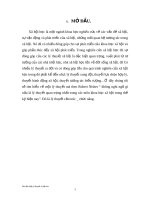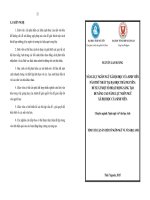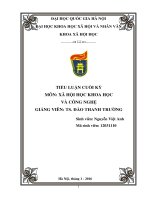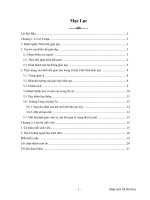TIỂU LUẬN NGÔN NGỮ XÃ HỘI HỌC
Bạn đang xem bản rút gọn của tài liệu. Xem và tải ngay bản đầy đủ của tài liệu tại đây (153.58 KB, 11 trang )
HUE UNIVERSITY
INSTITUTE OF OPEN EDUCATION
AND INFORMATION TECHNOLOGY
ENGLISH LANGUAGE
--------o0o--------
SOCIOLINGUISTIC PROJECT
Lecturer:
Trần Thuần
Student’s name:
Nhung
Hoàng Thị
Student’s code:
7052900543
Class:
Nghe An 6
Nghe An, July 2023
1
Topic: Compare two varieties of international English, taking account of the
social and historical forces (variables) which have brought about the differences. Are
these divergences (differences) more marked (clearly noticeable) in younger or older
speakers? Are they more marked in men or women?
******************************************
Abstract
Linguistics is concerned with the study of language, including theories of language as
discussed in Chapman’s Thinking about Language: Theories of English (TL:TE) and the
ways in which a language is structured and patterned as in Jeffries’ Discovering
Language: Describing English (DL:DE). ‘Language’ in this general sense can be
theorised and described in a general and abstract way, or we can be concerned with the
categorisation and description of a particular language, such as English. However, when
we come to consider how any language such as English is actually used in everyday life,
then it becomes clear that far from being spoken and written in exactly the same way by
everybody, language is in fact tremendously varied. This chapter considers different
spoken varieties of English, and the extent to which the society and communities in
which we live affect the ways in which we speak and write.
begins with definitions of language, dialect, accent, variety and standard English, and a
consideration of the attitudes people have towards variation in language use.
Outlines the history of the standardisation of English in England in order to illustrate why
dialectal variation persists in this region and throughout the United Kingdom as a whole.
This section also traces the origins of prejudicial attitudes towards variation that continue
to this day. By contrast, a consideration of the linguistic history of the USA shows how
the processes of standardisation have been very different from those in England. This
contrast explains why there is not the same degree of variation to be found in the USA as
in the UK, nor the same degree of prejudice towards non-standard varieties. These two
examples show how, although standardisation follows identifiable processes, the way in
which these processes are enacted in the case of individual language varieties varies a
2
great deal and depends upon a unique combination of social, economic, political,
geographic and historical variables.
Discusses research undertaken into variation based upon two different methodological
approaches: firstly, focus upon the linguistic variable; secondly, focus upon the social
variable and social networks. Studies into linguistic variation of phonology, morphology
and syntax are the focus of traditional dialectology such as the regionally based studies
undertaken by The Survey of English Dialects (1962) and Kortmann and Schneider’s
two-volume A Handbook of Varieties of English (2004). Studies into the social variable
are the focus of sociolinguistic dialectology, which also focuses upon the linguistic
variable, but also takes into account social issues such as race, class and gender in
relation to linguistic variation, such as those of Labov (1966, 1972, 1979) and Trudgill
(1974, 1978). More recently, Milroy (1987) and Milroy and Gordon (2003) have based
their sociolinguistic studies upon the notion of social networks, arguing that in addition to
linguistic and social variables, attention should also be paid to the communities and
contexts within which speech occurs.
Provides students with guidance and advice on undertaking their own studies into
variation and change, whilst section
Provides suggestions for further reading.
Let us consider the meaning of the term language and to what it refers. In DL:DE Jeffries
makes a distinction between language as a system and language use. A language system
refers to an idealised form of the language which is separate from how a language is
actually used, and DL:DE concentrates upon describing language as a system. In TL:TE
Chapman considers ‘language’ from different theoretical perspectives: as a type of
behaviour, as a state of mind and as a form of communication. A sociolinguistic approach
to the study of language considers language as behaviour, particularly in taking account
of the regional and social situations in which language occurs, and the social as well as
linguistic factors that affect how speakers relate to one another. Consequently, a
sociolinguistic approach to language behaviour, rather than being concerned with
language in a more general or abstract way, asks questions such as: ‘what is a language?’
3
and ‘what is language for?’ Language is not just about communication, but also about
identity, a factor which is paramount in sociolinguistics. Deciding which criteria to adopt
for defining a language, however, is far from straightforward. Take the example of the
language called ‘English’. Who are the speakers of English? Are they the people living in
a particular country, England, where the language is spoken? One popular way of
deciding the boundary of a language and boundaries between languages is to consider
their geography. We generally assume that people living in a particular geographically
defined country speak the language associated with it: French in France, German in
Germany and so on. ‘English’ by this definition is the language spoken by people living
in England, Great Britain (England, Scotland and Wales) and the United Kingdom
(England, Scotland, Wales and Northern Ireland). However, it is not always the case that
people living in a geographically defined area all speak the same language, or that one
language is the exclusive ‘property’ of a particular country. This is certainly not the case
with ‘English’, which is spoken not only in countries that make up the UK, but is also
widely used across many countries around the globe, including the United States.
Another factor which has to be taken into account is that English today is widely used in
many countries across the globe as the language of business, diplomacy, medicine and
the internet. We should also take account of the fact that there are many countries in the
world which are not monolingual: that is, they have not one nationally recognised
language, but several. For example, in Switzerland, there are three major languages:
German, French and Italian. Switzerland recognises itself as multi-lingual society
whereas most of us would agree that Britain (with the exception of Wales) unlike
Switzerland, is a monolingual society in that ‘everyone speaks English’. The same could
also be said of other countries across the globe, such as the USA, where English is the
language of official communication, used in educational contexts, the law, government,
the media and so on. However, if we look at the actual languages spoken in areas such as
the UK, USA or Australia today, then they include many others besides English. Far from
being monolingual, these countries, including those that make up the UK, are actually
multilingual, with many inhabitants speaking languages other than English. So although
the UK has an official language, ‘English’, its inhabitants actually come from a vast
range of language backgrounds, making the UK linguistically diverse. This is further
4
complicated by the fact that one of the countries which makes up Great Britain and the
UK, the principality of Wales, has two officially recognised languages, Welsh as well as
English, and all its inhabitants are taught to be bilingual. This situation is similar to the
one in Canada, where people are taught to be bilingual in French and English. In the
United States of America, there is no officially recognised national language, and
legislating to impose one is forbidden by its constitution, although to all intents and
purposes English functions as a national language through its use in public institutions
such as education, business and the law. What these examples all illustrate is that what
counts as a language then, is not only dependent upon geography, but also upon history,
politics and economics. The association between language and nation or nationality is a
very strong and powerful one. The association between language and identity of all kinds,
regional and social as well as national, is also very powerful. The language, languages or
varieties of a language that we speak form an integral part of who we are, and attempts at
imposing one language or variety of a language on the population of a nation are often
bound up with issues of power and ideology. The reasons why one language or one
variety of a language becomes associated with a particular nation are many and varied,
resulting from a combination of historical and social changes. Throughout history, one of
the first things an invading force of another country imposes upon the conquered people
is its language, particularly in terms of political, economic and educational institutions
and suchlike. For example, The Norman Conquest of 1066, the Roman invasion of the
first century BC and the altering of country boundaries in Eastern Europe post 1945 to
form the United Soviet States of Russia. What counts as the language of a country at any
particular moment in time, therefore, is not as simple and straightforward as it might at
first seem. The term ‘language’ is also a very difficult, if not impossible, one to define
linguistically, as the example in the following section illustrates.
The Ebonics Debate In December 1996 the Oakland School District Board in the
American State of California passed a resolution which gave official recognition to
Ebonics, a separate language and distinct from English. Ebonics is a compound word
made up of from the two words ‘Ebony’ meaning black and ‘phonics’ meaning sound, As
a consequence, schools in the Oakland District were required to recognise and accept
5
Black pupil’s speech in the classroom as part of a bilingual education program, so that
pupils would be taught both in their primary language, Ebonics, and in English. The
impetus for adopting such a resolution came from the persistently low educational
achievements obtained by black students in the district, who made up over fifty percent
of the school population. Although a local issue, the passing of this resolution quickly
became national news and precipitated a fierce debate across all the American States.
Amongst the issues raised by the Oakland resolution on Ebonics was whether or not
black English could be shown to be linguistically a separate language. The very raising of
this issue immediately brought to the fore another one, namely, the wider, more
politically sensitive one of the nature of the relationship between language and ethnicity,
and between African-Americans and Anglo-Americans in contemporary American
society. At the heart of the debate was not, as it tended to be presented in the press,
whether one was for or against Ebonics, but the far wider issue of equality: of equal
access to education for all American citizens regardless of ethnicity and through it, right
of access to a full participating status in American life regardless of class, ethnicity and
gender (Clark 2001:237-252). Tatalovich makes the point that whenever an opportunity
arises in America such as that provided by the Oakland Resolution to debate matters of
language, ‘ordinary people rise to defend the English language against those who speak
other tongues’ (1995:1). He points out that the Oakland Resolution, in common with
similar episodes throughout the history of the United States, ‘is symptomatic of the
debate over whether the United States should reflect a dominant English-speaking
majoritarianism or encourage a multilingual culture’ (1995:2). Consequently, for
Tatalovich, controversies over language such as those sparked by the Ebonics debate
become not only linguistic conflicts but also moral ones. Such controversy is further
compounded by the fact that, although English is by far the most common language
spoken and used in most areas of American public life, it has no official recognition as
the national language of all American states, nor indeed does any other language.
Furthermore, unlike many other major English speaking countries in the world, the US
Federal government has not been able to assert the dominance of English or legislate any
kind of national language policy through the education system, since neither language nor
education are enshrined in its constitution. One of the ways in which the United States
6
gets around this is by the importance it places on immigrants into the United States taking
a test in citizenship, which is in English. Not surprisingly, the Ebonics debate found its
way onto the agenda of the Linguistics Society of America. In 1997, the society passed a
resolution calling for the recognition of Ebonics, alongside African-American Vernacular
English (AAVE) and Vernacular Black English, to be recognised as systematic and
governed by linguistic rules. However, the society refused to be drawn upon the issue of
classification, on the grounds that the distinction between ‘languages’ and ‘dialects’ or
‘varieties’ is usually made more on social and political grounds than purely linguistic
ones. It argued that what was important from a linguistic and educational perspective was
not whether Ebonics or AAVE is called a ‘language’ but that they, in common with other
speech varieties, be recognised as systematic and governed by linguistic rules. At the
heart of the debate then, according to the Society, was not the linguistic issue of what
counts as a language, but more the social and political ones which surround the
establishment and maintenance of language hierarchies. If linguistics does not help us in
defining the term ‘language’, then maybe another way of defining language is in terms of
sub-divisions or as a collection of mutually intelligible dialects. In this way, we can talk
about the southwest dialect of France, the Black Country dialect of English, the Bavarian
dialect of German and so on. So, for example, English as a language includes not only its
standardised form known as standard English, but all other dialects which exist within the
geographical boundaries of England and elsewhere. However, mutual intelligibility as a
criterion is not very helpful, since different languages as well as dialects can be mutually
intelligible. For example, Norwegian, Swedish and Danish, though accepted as different
languages, can each be understood by the speakers of the other languages. Other factors
concerning intelligibility also have to be taken into account, such as the individual’s
degree of exposure to a language, her/his educational background and a willingness to
understand.
One way of defining a language is as a group of dialects and accents which have a certain
number of forms and structures in common. Put simply, dialect refers to words and
syntactic structure, whereas accent refers to the sounds that speakers produce and the
intonation and pitch which accompanies sound. If a dialect describes the words and
7
syntactic structures used by one person or a group of speakers, then accent is the word
used to describe pronunciation, and the two often go hand in hand. For example, if
someone speaks in a regional dialect of English such as Scouse in the North West or
Black Country in the Midlands, then her/his pronunciation will also be particular to that
area. If you were to walk north from Land’s End in Cornwall to John O’Groats at the
very north of Scotland, you would hear different accents and dialects of English –
Geordie in the North East, West Country in the South West and Cornish. This a known as
a dialect continuum or a chain of mutual intelligibility; that is, there is no distinct or
complete break from one dialect and accent to another, and speakers of geographically
adjacent dialects can understand one another. However, the cumulative effect of
linguistic differences is such that the greater the geographical separation, the greater the
difficulty of understanding what people say. Europe has many dialect continua, an
example of which is omance, stretching across the Iberian peninsula through France and
parts of Belgium down to the southern tip of Italy. In addition to a purely linguistically
descriptive dimension to accents and dialects, there is also a social one. Chambers and
Trudgill (1980:3) point out that dialects are commonly viewed as: …substandard, low
status, often rustic forms of language, generally associated with the peasantry, the
working class, or other groups lacking in prestige. DIALECT is also a term which is
often applied to other forms of language, particularly those spoken in more isolated parts
of the world, which have no written form. And dialects are often regarded as some kind
of (often erroneous) deviation from a norm – as aberrations of a correct or standard form
of language. Trudgill and Chambers found that people speaking with rural accents such
as those of Devon and Cornwall in South West England, for example, are typified as dimwitted but trusting, whereas people speaking with urban ones such as Cockney in London
are typified as quick-witted but untrustworthy. By contrast, speakers of standard English
with a Received Pronunciation accent are generally thought to be more intelligent than
speakers of other dialects and also superior morally as well as socially. Because of such
negative connotations, linguists have come to prefer to use the term variety when
describing variation in language. This has none of the negative connotations associated
with the terms dialect and accent, and fits in with the idea of descriptive linguistics: that
is, basing descriptions of language upon actual use. It can also be applied across a wider
8
range of language features than the terms dialect and accent. For example, we can talk of
linguistic variation, historical variation, social variation, geographic variation, stylistic
variation and so on. The main reason why there is so much geographical variation in
English throughout the United Kingdom and England especially, and throughout Europe
in general, is historical. Language operates across two dimensions simultaneously: the
horizontal dimension of space, also called the diachronic axis, and the vertical dimension
of time, called the synchronic axis. In addition, there is also a third, social dimension to
be considered, which accounts for variation between social classes and cuts across both.
The reason why, for example, there is so much variation in England today and so little in
the USA is historical. Similarly, the negative and prejudicial attitudes commonly held
towards linguistic variation, particularly in the UK, have their roots in history.
Consequently, in order to comprehend variation in English and attitudes held towards it,
it is important to consider the social history of English.
The term standard English (SE) is the one most commonly used to label the language
‘English’. It is the variety of English used in public life in England and other English
speaking countries, for example: in education, law, medicine and government.
Nowadays, it has no geographical boundary, and is used across the whole of England and
other English speaking countries. In England, it also has an accent associated with it,
known as Received Pronunciation: RP for short. Because of their origins and history, SE
and RP are closely associated with the language of the middle and upper classes in
English society, known variously as ‘the Queen’s English’ or ‘BBC English’. The
concept of RP is a peculiarly English one, having no equivalent in any other part of the
English speaking world. For example, there is no US equivalent of RP. Some linguists
have argued that SE is best defined as the written form of English, on the grounds that
standard English is not a matter of pronunciation and is thus not tied to any particular
accent (See: Crystal 1995 and Trudgill 1999). Rather, it is a matter of grammar,
vocabulary and orthography, that is, spelling and print face, and not of pronunciation.
Nevertheless, linguists such as Stubbs (1986) argue that accent is involved in notions of
standardness, since people have an idea of what is and is not ‘standard’ in pronunciation.
That is, the accent RP is widely regarded as the ‘standard’ accent of British English, just
9
as ‘standard English’ is widely regarded as the standard written form of English, as used
in education and other public institutions such as the law and government. Indeed, there
is much disagreement amongst linguists as to whether or not SE can be classed as dialect
at all. Some, such as Trudgill and Chambers (1980) and Milroy (1987) argue that it is,
pointing out that all speakers speak at least one dialect, and that standard English is as
much a dialect as any other form of English. Consequently, some speakers may have no
other variety than SE, whilst others may have either a regional variety and/or SE. Other
linguists disagree, on the grounds that standard English differs from other dialects in a
number of ways, especially in the fact that it has its own writing system. Because of this,
they argue that dialects and the study of dialect should concentrate upon speech. This
position, however, ignores the fact that many nonstandard English dialects in England
such as that found in the Black Country in the English West Midlands or Geordie in the
North East of England have an established tradition of writing. Also, if standard English
is not a dialect, then it is difficult to see what else it could be. As has already been
mentioned, whilst regional accents and dialects go hand in hand, standard English can be
spoken with any accent. So, although it is possible (but not very likely) that someone may
speak the Geordie dialect with an RP accent, it is both possible and probable that
someone may speak standard English with a Geordie accent. Indeed, the BBC, once an
important gatekeeper in the maintenance of standard English and RP, has in recent years
adopted a much more liberal policy towards the use of regional accents amongst its
presenters. When the BBC was founded in the 1930s, all broadcasters spoke standard
English with a uniform RP accent. Nowadays, no such training is given, and presenters
can be heard speaking standard English in a variety of different regional accents. Indeed,
attitudes towards the use of regional dialects and accents in public life has altered so
significantly since the 1930s that in 2005, the BBC launched a national campaign
celebrating and promoting regional English linguistic diversity called Voices. This
campaign, in addition to television and radio programmes, has used the internet and
phone-ins to undertake a national dialect survey on the use of regional dialects in England
today. Working together with dialectologists at the universities of Leeds and Cardiff, this
initiative aims to produce a comprehensive survey of contemporary English dialects and
accents. This BBC sponsored project takes issue with the correlation between RP and
10
BBC English, and is fighting hard to disassociate the BBC from any ‘gate-keeping’ role
in language use. It argues that the fact that BBC news broadcasters spoke RP in the early
days was more the product of a restricted group from which BBC employees were drawn
rather than as part of any deliberate policy. Even so, employees outside that group, at the
time, were given elocution lessons to ensure use of RP. The project also questions the
role of the BBC in championing a particular accent and thus potentially holding back the
tide of language change. It also takes issue with the fact that some linguists have
relabelled RP as BBC English, and called it such in pronunciation dictionaries for foreign
learners. However, if you call the accent normally used in BBC news broadcasts BBC
English, and that it is an example of RP, then by definition, the people the BBC employs
as news broadcasters are therefore RP speakers. This circularity in defining BBC English
in relation to RP and RP in relation to BBC English renders both concepts meaningless. It
is also ironic that this is happening at a time when the relationship between RP and socalled BBC English is more logically viewed as a thing of the past. Nevertheless,
initiatives such as Voices aside, there is still a strong correlation in Britain between
dialect, accent and social class. The social dialect of SE is bound not by geographical
region, but by social class.
11









